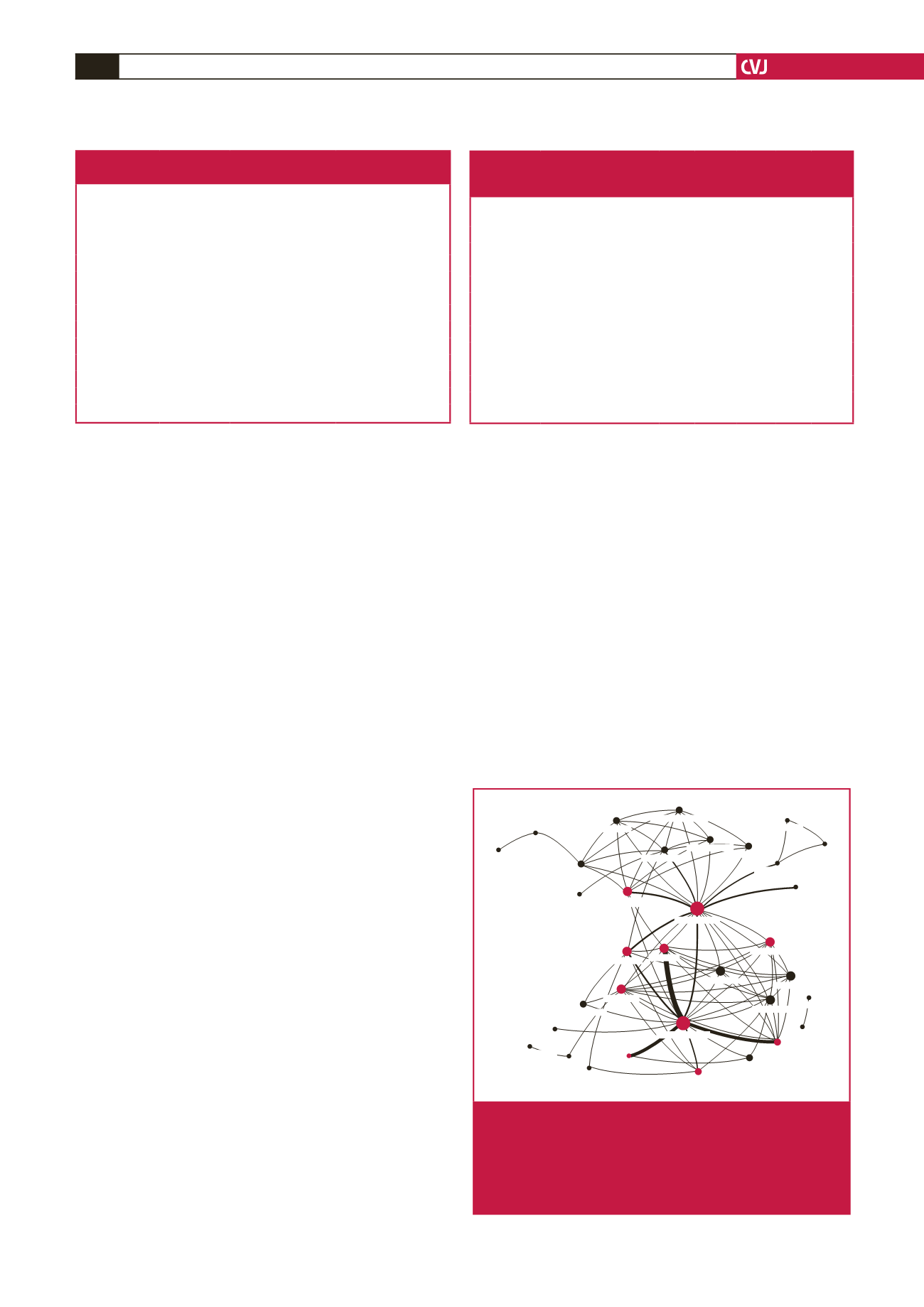

CARDIOVASCULAR JOURNAL OF AFRICA • Volume 27, No 3, May/June 2016
196
AFRICA
outside SSA. Eight of the 10 SSA countries had international
collaborations on more than 50% of their publications. South
Africa had the largest output over the decade with 1 016
publications, which was more than all the other SSA countries
combined. Collaboration with other countries accounted for
50% of the output from South Africa, compared with 23% from
Nigeria, which was the lowest in SSA. All of the publications
from Zimbabwe involved collaboration with other countries.
International collaboration in CVR in sub-Saharan
Africa
Table 2 presents the extent of collaboration in CVR between
the countries in SSA and the most frequent partner countries
outside the region. The data reflect instances of collaboration
between pairs of countries based on their co-occurrence in the
author affiliations of a given publication. In network analysis
terms, this is equivalent to the number of edges that any two
countries share. The numbers in parentheses represent the
percentage of the SSA country’s total instances of collaboration
that involved the non-SSA country or all of SSA.
South Africa recorded the highest instances of collaboration
in SSA, with 15% of those occurring with the USA. Countries
in SSA accounted for 4% of South Africa’s instances of
collaboration in CVR. Nigeria had the second highest instances
of collaboration in CVR, with the majority of these occurring
with the USA. Cameroon and Senegal had most of their
collaborations outside SSA with France, and the two countries
also had the highest percentages of collaboration instances with
SSA, at 37 and 41%, respectively.
Table 3 presents the instances of collaboration between the top
10 SSA countries in CVR. The numbers in parentheses represent
the percentage of an SSA country’s collaborations within SSA
that occurred with the paired SSA country. The highest number
of instances of collaboration occurred between South Africa
and Nigeria,
15
and this accounted for 27% of South Africa’s SSA
collaborations and 58% of Nigeria’s SSA collaborations. South
Africa accounted for the majority of instances of collaboration
for eight of the countries, with the exception of Senegal, which
collaborated mostly with Cameroon.
The network of collaboration in CVR between countries in
SSA can be visualised in Fig. 2. The network is based on the
subset of publications in which more than one SSA country was
present from authors’ affiliations. A total of 34 SSA countries
were involved in at least one instance of collaboration out of the
47 countries in the region. The size of any vertex is proportional
to the degree centrality, i.e. the number of countries with which
that country has an instance of collaboration.
Cameroon had the highest degree centrality
18
and eigenvector
centrality (0.087), indicating a high degree of collaboration
with other countries in the region, and playing a role as a
boundary spanner linking the French-speaking countries with
most of the English-speaking countries. The width of the edges
connecting pairs of countries is proportional to the frequency
of co-authorship or collaboration between these countries.
The thickest edge occurs between South Africa and Nigeria,
indicating the highest level of collaboration in CVR in the
region. South Africa also has strong collaboration in CVR with
Zimbabwe, Ghana and Mozambique.
Table 1. Number of cardiovascular research publications by
the top 10 countries in sub-Saharan Africa, 2005–2014
Country
Total number
of articles
published
Number of articles
that involved
international
collaboration
Percentage of
articles that involved
international
collaboration
South Africa
1016
507
50
Nigeria
228
52
23
Kenya
46
27
59
Cameroon
45
35
78
Uganda
37
30
81
Mozambique
35
31
89
Ghana
29
23
79
Senegal
29
13
45
Tanzania
17
15
88
Zimbabwe
12
12
100
Total
1494
745
50
Table 2. Number of instances of cardiovascular research collaboration
between the top 10 countries in sub-Saharan Africa and the most
frequent non-SSA partner countries, 2005–2014
Total
USA
(%)
England
(%)
Italy
(%)
France
(%)
Germa-
ny (%)
Canada
(%)
SSA
(%)
South Africa 1379 208 (15) 116 (8) 78 (6) 56 (4)
84 (6) 52 (4) 55 (4)
Nigeria
112 16 (14) 8 (7)
2 (2) 2 (2)
4 (4) 2 (2) 26 (23)
Cameroon
87 7 (8)
3 (3)
4 (5) 9 (10) 5 (6)
– 32 (37)
Uganda
82 17 (21) 10 (12) 7 (9) 4 (5)
3 (4) 3 (4) 12 (15)
Zimbabwe
76 1 (1)
5 (7)
2 (3) 1 (1)
– 4 (5) 16 (21)
Mozambique 61 5 (8)
6 (10)
– 14 (23) 1 (2) 2 (3)
9 (15)
Kenya
54 15 (28) 7 (13) 1 (2) 1 (2)
2 (4) 1 (2) 10 (19)
Ghana
51 8 (16) 4 (8)
– 2 (4)
5 (10) – 16 (31)
Tanzania
36 4 (11) 6 (17) 1 (3) 1 (3)
–
– 8 (22)
Senegal
34 2 (6)
1 (3)
– 8 (24)
–
– 14 (41)
The numbers in parentheses represent the percentage of the SSA country’s total
instances of collaboration that involved a non-SSA country or all of SSA.
Guinea
Benin
Togo
Congo
Zambia
Mauritius
Madagascar
Namibia
Ethiopia
Eritrea
Angola
Sudan
DR Congo
Seychelles
Chad
Gabon
Burkina Faso
Cote Ivoire
Mauritania
Mali
Botswana
Senegal
Nigeria
Ghana
Uganda
Tanzania
Cameroon
South Africa
Mozambique
Zimbabwe
Kenya
Malawi
Gambia
Rwanda
Fig. 2.
Network of cardiovascular research collaboration
among countries in SSA. The 10 countries in red
are those with the highest number of publications in
cardiovascular research from 2005 to 2014. The width
of the edges between countries reflects the extent of
collaboration between the pair based on co-authorship.

















